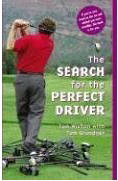The Search for the Perfect Driver
Golf book publishing is a bit like the movie business.
In both cases, if a product becomes a big hit, the producers will find a way to produce a sequel.
The follow-up might not measure up to the original, a risk perhaps best expressed by citing Caddyshack II, a truly wretched waste of film stock. On the other hand, sometimes the sequel improves on the original, which is how I view the second movie in the Godfather series.
It’s a bit early yet to gauge the eventual reception that Tom Wishon and Tom Grundner will receive for their follow-up book from their first bestseller, The Search for the Perfect Golf Club. For my taste, however, it’s a good effort that will mostly likely be rewarded.
In the first place, the two clubmakers focused on the club that many people believe is the most important one in the bag.
Of course, it’s really not. A 3-wood is a perfectly acceptable substitute for a driver in most conditions. On the other hand, there’s no equivalent alternative for a putter, which in any event is in a player’s hand about twice as often as the driver during a regulation round.
Even so, most folks are more impressed by long drives than a great putt, and that’s perfectly understandable from a visual and aesthetic perspective. Besides, if this book sells well enough, there’ll be another sequel opportunity for the flat stick.
The golf club companies are also more than happy to focus their marketing and research activities on new drivers. As their sales figures demonstrated in the last decade or so, folks will voluntarily plunk down several hundred dollars in the belief that the latest technical innovation will add umpteen yards to their drives. The market for putters priced at over $300 is far, far smaller.
Wishon and Grundner give the club companies their due respects, while also debunking some of the marketing speak that one can hear fellow players repeat on the first tee or the 19th hole.
For example, the latest wrinkle is to push the driver size to the current USGA-mandated limits of 460cc. If this was a motorcycle engine we were discussing, that one change would certainly make a difference compared to the 300cc or smaller offerings of just a few years ago.
For golf clubs, however, every increase in dimension brings along an added risk that the club will twist a bit in the player’s hands at the point of impact. Those tiny twists can easily add up to increased dispersion—in other words, fewer drives in the fairway, and more drives into trouble. There are ways to counter that effect, but the risk remains a fairly steep one for most golfers.
As their preferred alternative, Wishon and Grundner stress the importance of maintaining a sense of control of the driver during the downswing. They argue that the typical off-the-shelf driver has a shaft that’s simply too long for most players, and convincingly demonstrate the need to change the goal to making the center of the clubface hit the ball.
Their real point is the same one made in their first book. Custom clubfitting is not just for the pros or accomplished amateurs. The true beneficiaries of the few extra steps required for the club-fitting experience are the rest of us.
Using a question and answer format, the writers explain the pros and cons of each of the club’s constituent parts, and how the clubfitting process can improve a player’s prospects for enjoying the game even more with the right equipment for that player.
They even go the extra step of showing the readers how to have their new store-bought clubs adjusted by professional clubfitters. In most cases, they argue, the extra effort is well worth it, and the risk that a club can’t be fixed up for a particular player is not usually insurmountable. That little bit of clubfitter marketing might overcome the natural inertia resulting from having just bought a new club on sale at the local sports emporium.
No golf club can fix an awful golf swing, especially a driver. Nonetheless, if your golfing talents are within the normal range, this book shows how and why a custom-fitted driver will certainly add to the overall fun of the game.
Review Date: April 8, 2007


